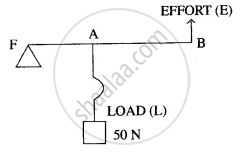Advertisements
Advertisements
Question
The following are an example of levers. State the class of lever to which each one belongs giving the relative positions of Load (L), Effort (E), Fulcrum (F):
(i) Scissors (ii) Sugar tongs (iii) Nutcracker (iv) Pliers.
Solution
| Name of Lever | Lever Class | Fulcrum | Position of Effort | Load | ||
| (i) | Scissors | First | At centre | One end | Other end | |
| (ii) | Sugar tongs | Third | One end | At centre | Other end | |
| (iii) | Nutcracker | Second | One end | Other end | At centre | |
| (iv) | Pliers | First | At centre | One end | Other end | |
APPEARS IN
RELATED QUESTIONS
Draw a diagram of a lever which is always used as a force multiplier. How is the effort arm related to the load arm in such a lever?
Fig 3.17 below shows a lever in use.

(a) To which class of lever does it belong?
(b) If FA = 80 cm, AB = 20 cm, find its mechanical advantage.
(c) Calculate the value of E.
Which type of levers have mechanical advantage always more than 1? Give reasons.
Which class of lever found in the human body is being used by a boy when he holds a load on the palm of his hand.
The following belong to which class of lever?
A claw-hammer
The following belong to which class of lever?
Rowing of a boat
The following belong to which class of lever?
A fire tongs
The following belong to which class of lever?
Sugar tongs
The following belong to which class of lever?
Knife
The diagram below shows a lever in use.

(i) To which class of lever does it belong?
(ii) If FA = 40 cm, AB = 60 cm, then find the mechanical advantage of the lever.
